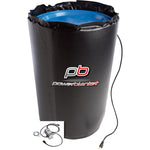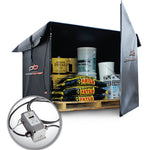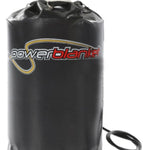You have no items in your shopping cart.
Why Freezing and Curing Don't Mix
Article At-a-Glance
How Can You Successfully Cure Concrete in Cold Weather?
To successfully cure concrete in cold weather, maintain the concrete temperature between 50°F and 70°F using insulating blankets, heated enclosures, or chemical admixtures. Proper site preparation and continuous temperature monitoring are key to preventing freezing and ensuring optimal strength development.
Key Takeaways
- Understand Cold Weather Challenges: Freezing conditions can halt hydration, weaken the concrete, and cause long-term structural issues. Keeping the mix within the ideal temperature range is essential.
- Prepare the Site and Materials: Warm tools and materials before pouring, clear snow, and shield the area from wind and temperature swings for optimal results.
- Use Effective Curing Techniques: Apply insulating blankets, heated enclosures, or chemical admixtures to maintain consistent curing temperatures.
- Monitor and Protect: Use infrared temperature tools to track curing temperatures and shield the concrete from freezing, wind, and direct sun exposure.
- Follow Best Practices: Consult American Concrete Institute guidelines and local building codes, and evaluate safety and environmental considerations when using heating solutions.
Curing concrete in cold weather is crucial for construction projects in areas with freezing temperatures. When the temperature drops below 40°F, the curing process slows down, and the concrete may not reach its full strength potential. Therefore, it's essential to protect fresh concrete from freezing temperatures and ensure that the curing process occurs at the proper temperature. In this article, we'll explore several ways to cure concrete in cold weather effectively.
At 77 - 81 °F (25 – 27 °), the freeze in the concrete will stop the hydrating and healing processes. Hydration is a chemical reaction in which cement's key substances form chemical bonds with water molecules and are transformed into hydrate and hydration materials. The formation of ice in cured concrete may affect its stability in the long term through cracking. This photograph shows enclosed and heated concrete cures in tiger gates and trunnion concrete replacement. The air temp reached 15 degrees during the pouring in Altona, Wisconsin in the above photo.

Understanding the Challenges of Cold Weather Concrete Curing
Cold-weather concrete curing poses unique challenges that contractors should be aware of to ensure that the concrete cures properly. Low temperatures can cause the concrete to freeze, leading to significant structural damage. Low temperatures can also slow the chemical reaction between cement and water, leading to weaker concrete. Therefore, it's crucial to maintain the concrete temperature between 50°F and 70°F during the curing process. Insulation, heating systems, and chemical admixtures are three effective ways to cure concrete in cold weather.
Prepare the Site and Materials Before Pouring the Concrete
The concrete should be prepared to warm before you pour it during the hot season. The temperature of the water should be at least 90C to compensate for cold weather. Remove snow from this area. Protect workers and concrete against winds and conditions resulting in rapid temperature drops and water loss. Cold tools, especially cold forms, can alter concrete's quality and strength; keep them inside.

$1,915.99 USD
10’ x 10’ Multi-Duty Thawing & Concrete Curing Blanket (120V)
3 Tips for Successful Concrete Curing in Cold Weather
-
Insulating Blankets
Insulating blankets is an effective way to maintain the proper concrete temperature during curing. They can be used for small and large concrete pours, such as walls, columns, and slabs. The blankets are placed over the concrete surface to prevent heat loss. Careful attention should be given to the edges of the concrete to prevent cold air from seeping in. Additionally, monitoring the concrete temperature regularly is essential to ensure proper curing.

To use insulating blankets effectively, the concrete should be placed as soon as possible to minimize heat loss during transport. The blankets should be placed over the concrete surface immediately after the concrete is poured. It's crucial to ensure that the blankets are in good condition and that no holes or gaps allow cold air to seep in. Additionally, it's essential to ensure that the blankets are weighted down to prevent wind from blowing them away.
-
Heated Enclosures
Heated enclosures are another effective way to cure concrete in cold weather. They are typically used for large concrete pours, such as foundations or slabs. The enclosure is heated using propane or electric heaters to maintain the proper concrete temperature. It's essential to ensure the enclosure is adequately sealed to prevent heat loss and maintain a consistent temperature.
When using heated enclosures, it's crucial to ensure that the heaters are positioned correctly and that there are no fire hazards. Additionally, it's essential to ensure that the enclosure is adequately ventilated to prevent carbon monoxide poisoning. Heated enclosures should be monitored regularly to maintain the concrete temperature within the recommended range.
-
Chemical Admixtures
Chemical admixtures are additives used in the concrete mix to accelerate curing in cold weather. Calcium chloride is the most commonly used chemical admixture for cold weather concreting. It helps the concrete to set and gain strength quickly, even in low temperatures. However, care should be taken when using these admixtures as they can affect the final appearance of the concrete.
To use chemical admixtures effectively, following the manufacturer's instructions carefully is crucial. The admixture should be added to the concrete mix during mixing, and the concrete should be placed immediately after mixing. Additionally, it's essential to ensure that the concrete temperature is maintained within the recommended range during the curing process.

Next Steps:
Monitoring the Concrete Temperature
Monitoring the concrete temperature is crucial for proper curing in cold weather conditions. An infrared temperature gun can be used to measure the concrete temperature accurately. Additionally, it's essential to ensure that the concrete is poured when the air temperature is above freezing to prevent early freezing.
Protecting Fresh Concrete
Protecting fresh concrete is crucial to ensure proper curing in cold weather. The concrete should be protected from freezing temperatures and cold tools and equipment. Additionally, the concrete surface should be protected from wind and sun to prevent rapid evaporation of the bleed water.
Proper Curing
Proper curing of concrete in cold weather is essential for the durability and strength of the concrete. The curing process should be continued for a minimum of seven days, depending on the concrete mix and weather conditions. The concrete surface should be kept moist to prevent the rapid evaporation of the bleed water.
Choosing the Right Curing Solutions for Your Project
The process of curing concrete in colder temperatures requires careful planning and implementation to ensure that the concrete cures properly. Insulating blankets, heated enclosures, and chemical admixtures are three effective ways to cure concrete in cold weather. Monitoring the concrete temperature, protecting fresh concrete, and proper curing is crucial for the durability and strength of the concrete. By following the methods outlined in this article, contractors can ensure that their concrete pours are successful even in cold weather conditions. It's crucial to consult the American Concrete Institute guidelines and local codes to ensure the concrete is cured properly.
Contractors should consult the American Concrete Institute guidelines and local codes to ensure that the concrete is cured properly. It's also essential to take safety and environmental precautions when curing concrete. Heaters should be used with caution to prevent fire hazards, and adequate ventilation should be provided to prevent carbon monoxide poisoning. Additionally, it's essential to consider the environmental impact of using heating systems, which can lead to increased energy consumption and greenhouse gas emissions.
If you're looking for a reliable supplier of heating blankets for concrete curing in cold weather, Heat Authority can help. We have a team of experts who can help you find the right product for your needs, whether a ready-to-ship product or a custom solution. Our heating systems are designed to maintain the proper concrete temperature during curing, ensuring that your concrete reaches its full strength potential. We offer many different sizes of heated curing blankets, including custom sizes, so that we can help you complete your project on time, no matter how big your project is. Contact us today to learn more about how we can help you cure your concrete correctly, even in cold weather conditions.













